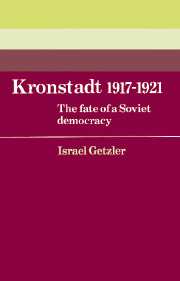Book contents
2 - The February revolution in Kronstadt
Published online by Cambridge University Press: 29 September 2009
Summary
News of the unrest in Petrograd, notably of the mutiny on 27 February 1917, when troops ordered to shoot at the demonstrating crowds and striking workers disobeyed and instead joined the masses, seeped through to the garrison and workers of Kronstadt despite the precautionary measures, including the ban on newspapers, that Viren had taken since 25 February to insulate Kotlin Island from the outside world.
Not surprisingly, Viren did not quite grasp the nature of events and felt duty bound to try to reverse them, only desisting from his plan to use Kronstadt troops to help crush the Petrograd uprising after his officers told him that the lower ranks would ‘join the insurgents’.
Nevertheless, determined to hold out and prevent the revolution spreading to Kronstadt, Viren placed field cannons and machine-guns on the pier, aimed at the road leading over the ice to Oranienbaum on the mainland, and he may also have given orders to the officers of the Third Kronstadt Fortress Infantry Regiment to keep their troops on the ready near the Petrograd Gates. At the same time he posted orders throughout Kronstadt, prohibiting gatherings, meetings and speeches, threatened to take reprisals with his ‘fatherly hand’, and his appeal ‘To the Workers and Residents of Kronstadt’ handed down the ‘fatherly advice’ that ‘everyone carry on normally’ both for ‘the general good and for his own personal well-being’. In the same vein, when the workers of the steamship plant went on strike on 28 February and their spokesman, the young worker Tsygankov, presented Viren with their demands and asked him to explain the Petrograd happenings to them, he told them he would address them the next day in Anchor Square, but at the same time gave orders to place machine-guns in the naval cathedral overlooking the square.
- Type
- Chapter
- Information
- Kronstadt 1917–1921The Fate of a Soviet Democracy, pp. 19 - 68Publisher: Cambridge University PressPrint publication year: 1983



